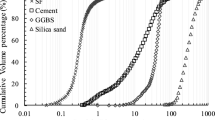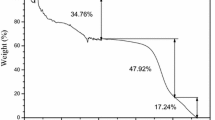Abstract
Aimed at reducing drying shrinkage of Engineered Cementitious Composites (ECC) and uncovering the significance of curing method as to ECC with additives, twenty groups of specimens were designed and tested in this paper. Influence of expansive agent, curing method (dry curing, standard humid curing, and 3d/7d early-water-curing composited with later-dry-curing), and curing age on the compressive strength, uniaxial tension properties, free and restrained drying deformation properties of ECC were comprehensively studied. The results indicate that the addition of expansive agent reduces the compressive strength of ECC, and the early strength is relatively low followed by a gradual development. Besides, sufficient long-term curing guarantees the strength development of ECC with expansive agent mixed. Both high tensile strength 7.16 MPa and ductility 4.77% can be obtained by early sufficient curing and later dry environment, respectively. With increasing the content of the expansive agent, the tensile cracks become finer and even invisible. The mixed expansive agent ensures the quantity of potential ettringite while an appropriate curing method contributes to the formation of it. It reduces drying shrinkage, offsets other kinds of shrinkage, and transforms the stress state of restrained ECC from shrinkage to expansion, reducing the risk of cracking. Evaluating the deformation of ECC with expansive agent under different curing conditions is necessary to avoid harmful expansive deformation, especially when it is restrained. The study provides credible and valuable experimental data and suggestions for facilitating the application of ECC with the characteristic of low drying shrinkage in practice.












Similar content being viewed by others
References
Neville AM (2011) Properties of concrete, 5th edn. Pearson Education Limited, Essex
Cadoni E, Meda A, Plizzari GA (2009) Tensile behaviour of FRC under high strain-rate. Mater Struct Constr 42:1283–1294. https://doi.org/10.1617/s11527-009-9527-6
Li VC (2019) Engineered cementitious composites (ECC). Springer, Germany
Gao S, Wang Z, Wang W, Qiu H (2018) Effect of shrinkage-reducing admixture and expansive agent on mechanical properties and drying shrinkage of engineered cementitious composite (ECC). Constr Build Mater 179:172–185. https://doi.org/10.1016/j.conbuildmat.2018.05.203
Leung CKY, Li VC (1992) Effect of fiber inclination on crack bridging stress in brittle fiber reinforced brittle matrix composites. J Mech Phys Solids 40:1333–1362. https://doi.org/10.1016/0022-5096(92)90018-W
Li VC, Leung CKY (1992) Steady-state and multiple cracking of short random fiber composites. J Eng Mech 118:2246–2264. https://doi.org/10.1061/(ASCE)0733-9399(1992)118:11(2246)
Li VC (2002) Advances in ECC research. ACI Spec Publ Concr Mater Sci Appl 206:373–400
Weimann MB, Li VC (2003) Hygral behavior of engineered cementitious composites (ECC). Int J Restor Build Monum 9:513–534
Yang E, Yang Y, Li VC (2007) Use of high volumes of fly ash to improve ECC mechanical properties and material greenness. ACI Mater J 104:620–628. https://doi.org/10.14359/18966
Li M, Li VC (2006) Behavior of ECC-concrete layered repair system under drying shrinkage conditions. Restor Build Monum 12:143–160. https://doi.org/10.1515/rbm-2006-6040
Wang Q, Zhang J, Fan J, Zheng X (2018) Cracking load of high strength ECC-steel composite bridge deck with impact of shrinkage stress—test and simulation. Eng Fract Mech 202:174–201. https://doi.org/10.1016/j.engfracmech.2018.09.018
Şahmaran M, Lachemi M, Hossain KMA, Li VC (2009) Internal curing of engineered cementitious composites for prevention of early age autogenous shrinkage cracking. Cem Concr Res 39:893–901. https://doi.org/10.1016/j.cemconres.2009.07.006
Yao Y, Zhu Y, Yang Y (2012) Incorporation superabsorbent polymer (SAP) particles as controlling pre-existing flaws to improve the performance of engineered cementitious composites (ECC). Constr Build Mater 28:139–145. https://doi.org/10.1016/j.conbuildmat.2011.08.032
Serpukhov I, Mechtcherine V (2015) Early-Age Shrinkage of Ordinary Concrete and a Strain-Hardening Cement-Based Composite (SHCC) in the Conditions of Hot Weather Casting. Int Conf Mech Phys Creep Shrinkage Durab Concr Concr Struct. https://doi.org/10.1061/9780784479346.176
Zhang J, Wang Q, Zhang J (2017) Shrinkage of internal cured high strength engineered cementitious composite with pre-wetted sand-like zeolite. Constr Build Mater 134:664–672. https://doi.org/10.1016/j.conbuildmat.2016.12.182
Weimann MB, Li VC (2003) Drying shrinkage and crack width of engineered cementitious composites (ECC). Brittle Matrix Compos 7:37–46. https://doi.org/10.1533/9780857093103.37
Zhang J, Gong C, Guo Z, Zhang M (2009) Engineered cementitious composite with characteristic of low drying shrinkage. Cem Concr Res 39:303–312. https://doi.org/10.1016/j.cemconres.2008.11.012
Zhang J, Gao Y, Wang Z (2013) Evaluation of shrinkage induced cracking performance of low shrinkage engineered cementitious composite by ring tests. Compos Part B Eng 52:21–29. https://doi.org/10.1016/j.compositesb.2013.03.012
Cheung AKF, Leung CKY (2011) Shrinkage reduction of high strength fiber reinforced cementitious composites (HSFRCC) with various water-to-binder ratios. Cem Concr Compos 33:661–667. https://doi.org/10.1016/j.cemconcomp.2011.03.009
Keskin SB, Sahmaran M, Yaman IO, Lachemi M (2014) Correlation between the viscoelastic properties and cracking potential of engineered cementitious composites. Comput Chem Eng 71:375–383. https://doi.org/10.1016/j.conbuildmat.2014.08.089
Corinaldesi V, Nardinocchi A (2016) Mechanical characterization of engineered cement-based composites prepared with hybrid fibres and expansive agent. Compos Part B Eng 98:389–396. https://doi.org/10.1016/j.compositesb.2016.05.051
Costa FBPD, Righi DP, Graeff AG, Silva Filho LCPD (2019) Experimental study of some durability properties of ECC with a more environmentally sustainable rice husk ash and high tenacity polypropylene fibers. Constr Build Mater 213:505–513. https://doi.org/10.1016/j.conbuildmat.2019.04.092
Felekoglu B, Tosun-Felekoglu K, Ranade R et al (2014) Influence of matrix flowability, fiber mixing procedure, and curing conditions on the mechanical performance of HTPP-ECC. Compos Part B Eng 60:359–370. https://doi.org/10.1016/j.compositesb.2013.12.076
Zhu Y, Zhang Z, Yao Y et al (2016) Effect of water-curing time on the mechanical properties of engineered cementitious composites. J Mater Civ Eng 28:04016123. https://doi.org/10.1061/(asce)mt.1943-5533.0001636
Chinese Standard GB/T 50082 (2009) Standard for test methods of long-term performance and durability of ordinary concrete
Chinese Standard GB/T 50081 (2019) Standard for test methods of concrete physical and mechanical properties
Chinese Standard JGJ/T 70 (2009) Standard for test method of basic properties of construction mortar
Japan Society of Civil Engineers (2008) Recommendations for design and construction of high performance fiber reinforced cement composites with multiple fine cracks
American Society for Testing and Materials ASTM C 1581 (2009) Standard test method for determining age at cracking and induced tensile stress characteristics of mortar and concrete under restrained shrinkage
American Association of State Highway and Transportation Officials PP 34–99 (2005) Standard practice for estimating the cracking tendency of concrete
Meddah MS, Suzuki M, Sato R (2011) Influence of a combination of expansive and shrinkage-reducing admixture on autogenous deformation and self-stress of silica fume high-performance concrete. Constr Build Mater 25:239–250. https://doi.org/10.1016/j.conbuildmat.2010.06.033
Jang SJ, Kim JH, Kim SW et al (2019) The effect of shrinkage-compensation on the performance of strain-hardening cement composite (SHCC). Sustain. https://doi.org/10.3390/su11051453
Redon C, Li VC, Wu C et al (2001) Measuring and modifying interface properties of PVA fibers in ECC matrix. J Mater Civ Eng 13:399–406. https://doi.org/10.1061/(asce)0899-1561(2001)13:6(399)
Yan P, Qin X, Yang W, Peng J (2001) The semiquantitative determination and morphology of ettringite in pastes containing expansive agent cured in elevated temperature. Cem Concr Res 31:1285–1290. https://doi.org/10.1016/S0008-8846(01)00563-4
Han J, Jia D, Yan P (2016) Understanding the shrinkage compensating ability of type K expansive agent in concrete. Constr Build Mater 116:36–44. https://doi.org/10.1016/j.conbuildmat.2016.04.092
Hua C, Acker P, Ehrlacher A (1995) Analyses and models of the autogenous shrinkage of hardening cement paste. I. Modelling at macroscopic scale. Cem Concr Res 25:1457–1468. https://doi.org/10.1016/0008-8846(95)00140-8
Xi B, Zhou Y, Yu K et al (2020) Use of nano-SiO2 to develop a high performance green lightweight engineered cementitious composites containing fly ash cenospheres. J Clean Prod 262:121274. https://doi.org/10.1016/j.jclepro.2020.121274
Acknowledgements
This study was funded by the National Natural Science Foundation of China (Key Program, 52130210), National Key R&D Program of China (2017YFC0703700) and Victoria-Jiangsu Innovation and Technology R&D Fund (BZ2020019). The authors would like to thank the Jiangsu Southeast University Testing and Inspection Technology Co. Ltd for providing instruments and equipments.
Author information
Authors and Affiliations
Corresponding author
Ethics declarations
Conflict of interest
We declare that we have no financial or personal relationships with other people or organizations that can inappropriately influence our work, there is no professional or other personal interest of any nature or kind in any product, service or company that could be construed as influencing the position presented in the manuscript entitled, “Influence of expansive agent and curing method on the mechanical and drying deformation properties of Engineered Cementitious Composites (ECC)”.
Additional information
Publisher's Note
Springer Nature remains neutral with regard to jurisdictional claims in published maps and institutional affiliations.
Rights and permissions
About this article
Cite this article
Jiang, B., Qian, Z. & Pan, J. Influence of expansive agent and curing method on the mechanical and drying deformation properties of Engineered Cementitious Composites (ECC). Mater Struct 55, 58 (2022). https://doi.org/10.1617/s11527-022-01895-y
Received:
Accepted:
Published:
DOI: https://doi.org/10.1617/s11527-022-01895-y




